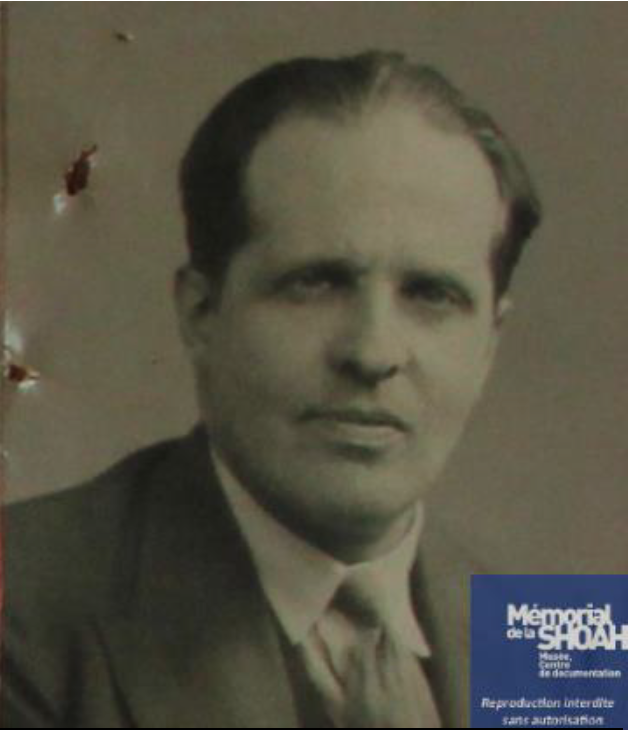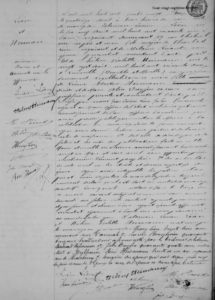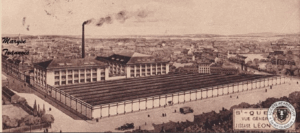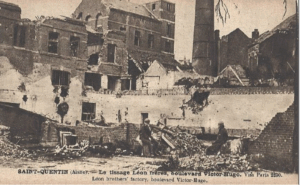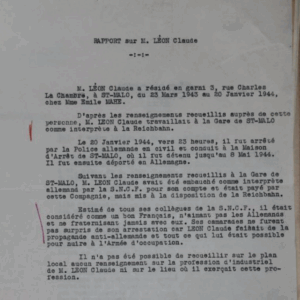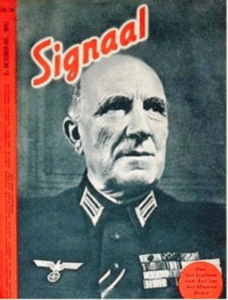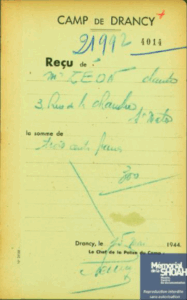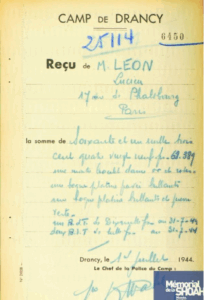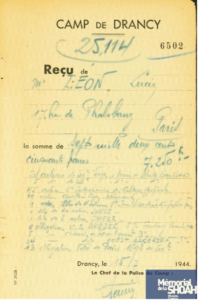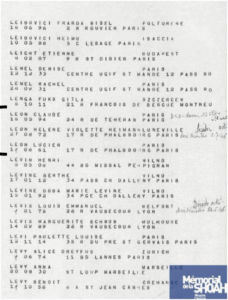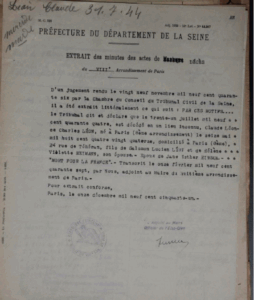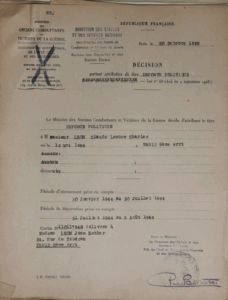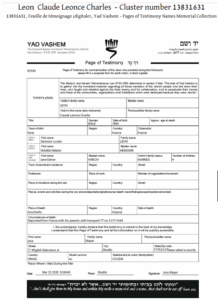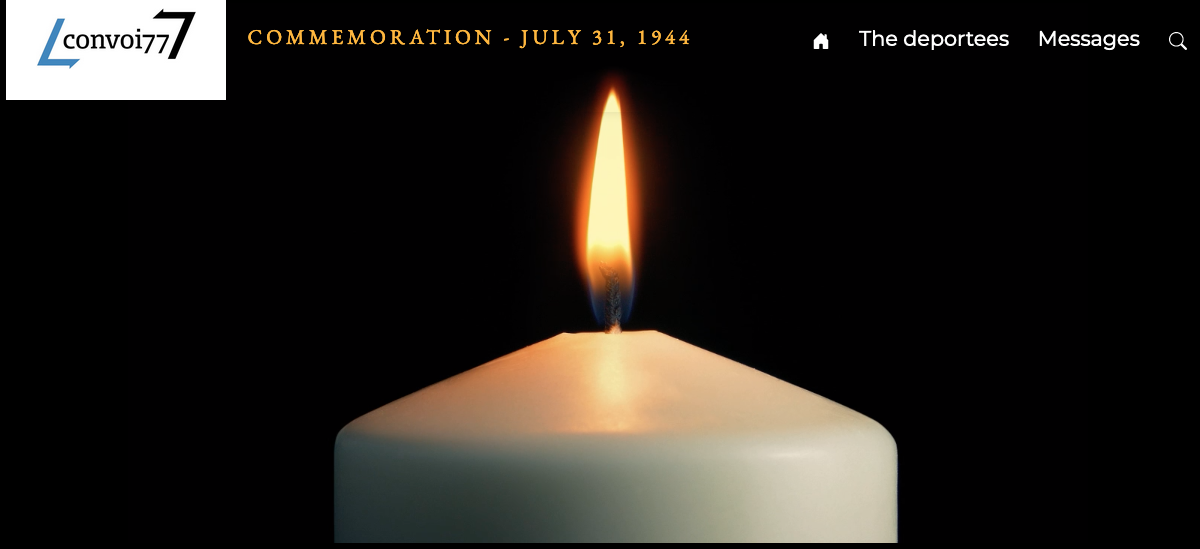Claude LÉON
Photo of Claude Léon
Source: Claude Léon ©Shoah Memorial, Paris
Claude (Léonce Charles) Léon was born on May 16, 1894 at 10, rue de Florence in the 8th district of Paris. He was a French citizen and Jewish.
Claude Léon’s birth certificate
Source: ©Paris Archives
Claude’s parents were Salomon Lucien Léon (born 1861 in the 16th district of Paris, died 1944 in Auschwitz), a broker, and Hélène Violette Léon, née Heimann (born in 1872 in Lunéville, now in the Meurthe-et-Moselle department of France, died in 1944 in Auschwitz). When Claude was born, they were living 10 rue de Florence in the 8th district of Paris. They were married the previous year, on April 14, 1893 in the 17th district of Paris. Claude appears to have been an only child.
Claude’s parents’ marriage certificate
Source: file on Claude Léon ©Paris archives
A heroic contribution to the First World War
Claude’s army service record includes a physical description of him: he was just over 5’6” tall, had dark chestnut brown hair, blue eyes, covered forehead, medium-sized nose and an oval face.
It also reveals that Claude Léon was mobilized in October 1914. He was supposed to join the 6th Regiment, but was discharged due to “insufficient heart development”.
Nevertheless, he volunteered again in May 1915 in Troyes, in the Aube department of France, and joined the 2nd heavy artillery regiment.
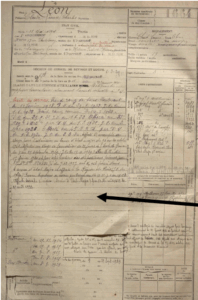
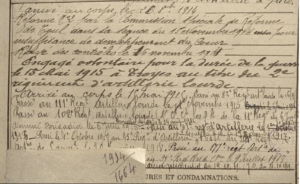
Service record sheet N°1664
Close-up of the “service” section
Source: file on Claude Léon ©Paris archives
ref. FRADO75RM-D4R1-1826-0309 à 0311
Close-up of the” Injuries, awards” section of the service record
Claude Léon’s military service file contains various details about his personal qualities and conduct during the war. He is described as a “valuable officer”, “an excellent liaison officer” and commended for his “composure and fearless bravery”. In recognition of this, he was awarded the French War Cross and two commendations in the regimental order. He was demobilized on September 8, 1919. He went on to train at the French War School in 1929 and was promoted to the rank of reserve captain in 1933.
His maternal uncle, Georges Sylvain Heimann, who was an official witness when Claude’s birth was declared, was a corporal in the army and died on the front in October 1914.
After the First World War
Although Claude Léon had studied law, he chose to work in the family business, “Léon Frères” (Léon brothers). His grandfather, Charles Léon (1826-1889) and his grand-uncle (i.e. Claude’s grandfather’s brother, often known in English as great-uncle), Alexandre Léon, (1833-1907) had founded the company. They had two weaving factories in Saint-Quentin, in the Aisne department of France.
During the First World War, the Germans took over the factories, which were heavily bombed and had to be demolished. In 1922, employees gradually moved into new premises on one single site, on boulevard Victor Hugo. The Léon Frères company also built a workers’ housing estate, which was named after its founders.
The Léon Frères factory at Saint-Quentin before the war
Source : www.sastq.fr
The factory after the First World War
Source : www.geneanet.org
The shares in the business were split three ways: Lucien Léon, Claude’s father (37,500 francs), Eugène Léon, his grand-uncle’s son (150,000 francs) and Claude himself (112,5000 francs). The company’s head office was at 160 Rue Montmartre in Paris.
On July 11, 1923, in Neuilly-sur-Seine, in the western suburbs of Paris, Claude married Jane Esther Hirsch (born January 23, 1904 in Joigny, in the Vaucluse department of France, died August 8, 1995 in the 14th department of Paris). The following day, a religious ceremony was held at the Victoire synagogue in Paris. A Paris notary, Mr. Guitton, drafted their marriage contract.
In 1932, the couple rented an apartment and set up home at 24 Rue de Téhéran, in the 8th district of Paris. They went on to have four children: Vincent (1924-2002), Bruno (1925-1994), Thierry (1932-2005) and François (born September 27, 1940). In 1940, however, the relationship was no longer working and they split up. During the German Occupation, when France was divided into two zones (a German Occupied zone in the northern half of the country and Free zone in the south), Jane Esther Hirsch left Paris and moved to Puy-de-Dôme department, which was in the Free Zone.
The arrest
We do not know where Claude Léon lived or what he did between 1941 and 1943, but in 1941, the Germans “Aryanized” the Léon Frères business and appointed a temporary manager, Mr. Léon Leriche, and then Alexis Chatelain, the previous manager, who had been demobilized.
We next caught up with Claude Léon in 1943, in Saint-Malo, an ancient port city in Brittany, in the north west of France, but we do not know how or why he ended up there. From March 23 1943 to January 20, 1944, he lodged with a Mrs. Emile Mahé at 3 rue Charles La Chambre, a house which has since been demolished. He was employed by the SNCF, the French national railway company, but was seconded to the Reichbahn (German national railroad company). He worked at Saint-Malo station as an interpreter, which is quite surprising considering he was Jewish. However, a French police report on an investigation carried out by the Ille-et-Vilaine prefecture in January 1955 suggests that Claude Léon had been involved in the Resistance. It states that “he did not like the Germans and never mixed with them. His colleagues were not surprised when he was arrested, as Claude Léon was involved in anti-German propaganda and did everything he could to undermine the occupying forces”.
We can safely assume therefore that Claude Léon was active in the Resistance, even though we found no evidence that he belonged to any particular network.
Report on Claude Léon
Source: file on Claude Léon © Victims of Contemporary Conflicts Archives Division of the French Ministry of Defense Historical Service, in Caen, dossier n°21P 476-13133018
In 1954, his wife appeared to confirm this, stating “that arrangement was a cover-up”.
Source: file on Claude Léon ©Victims of Contemporary Conflicts Archives Division of the French Ministry of Defense Historical Service, in Caen, dossier n°21P 476-13133018
At 11pm on January 20, 1944, the Gestapo arrested Claude at his apartment in Saint-Malo. His landlady, Mrs. Mahé, later told his wife that “the police came during the day, and rummaged through everything”. The exact reasons for his arrest are not known. In February 1954, the French department that dealt with deportees noted with astonishment that Claude Léon, who had been awarded the French Legion of Honor, had gone to offer the Germans his services as an interpreter of his own accord: “an ill-advised move, given that his wife, Jane Esther’s maiden name was Hirsch, and that it was inevitable that she would be investigated next”.
His wife also stated that he was arrested on grounds of his “race”.
According to Claude’s youngest son, François, who heard it from his mother, Jane Esther, the family had been paying a high-ranking French collaborator, Jean de Mayol de Lupé[1], so Claude would not be arrested. But then, when they no longer had the means to pay the protection money, Claude and his parents were all arrested at around the same time (Claude in Saint-Malo, his parents in Paris). There are no records to support this claim however.
Jean de Mayol de Lupé
Claude was initially taken to the local jail in Saint-Malo, but transferred to Rennes, the main town in Ile-et-Vilaine, three days later. On May 15, 1944, the day before his birthday, he arrived in Drancy internment camp, north of Paris, where he was assigned prisoner number 21,992.
Claude’s search receipt from Drancy
Source: file on Claude Léon © Shoah Memorial, Paris
Claude’s father, who by then was 82 years old and was living at 17, rue de Phalsbourg in the 17h district of Paris, was interned in Drancy on July 14, 1944, together with his wife. When he arrived, he was searched and found to be carrying 61,389 francs in cash, some jewelry, bank shares and bonds, safe deposit box keys and a cheque book from the Banque de France. These were all confiscated and he was given several receipts for them. He was then assigned prisoner number 25,114.
Two of Claude’s father Lucien’s receipts from Drancy
Source: file on Lucien Léon ©Mémorial de la Shoah
It was probably Claude’s arrest that prompted SS commandant Aloïs Brunner, who was in charge of Drancy camp, to order the arrest of his parents. Such a well-known family would almost certainly have registered themselves as Jews when required to do so in 1940, so it would have been easy to find them.
Deportation to Auschwitz-Birkenau
On July 31, 1944, Claude and his parents were deported on Convoy 77 to the Auschwitz-Birkenau concentration camp and killing center, where they were most likely sent to the gas chambers and murdered soon after they arrived.
The Convoy 77 deportation list, including the names of Claude and his parents
Source: file on Claude Léon © Shoah Memorial, Paris
After the war
On November 29, 1946, Claude was officially declared to have “Died for France”. As a result, his wife was able to claim a widow’s pension. Paul Léon, a cousin of Salomon Lucien Léon, Claude’s father, was appointed as the children’s legal guardian.
Claude Léon’s death certificate
Source: file on Claude Léon ©SHD de Caen DAVCC, Dossier n°21P 476-13133018
In 1955, Jane succeeded in having Claude officially recognized as a “Political deportee”.
In July 2000, one of his sons, Vincent, asked the French authorities for a missing person’s certificate.
In 2020, a cousin, José Meyer, submitted a testimonial sheet on the Yad Vashem website.
Confirmation of the decision to grant Claude political deportee status
Source: file on Claude Léon © Victims of Contemporary Conflicts Archives Division of the French Ministry of Defense Historical Service, in Caen, dossier n°21P 476-13133018
Testimonial sheet on the Yad Vashem website
Source : yadvashem.org
We would like to thank François Léon, Claude’s last living son, who never knew his father but was kind enough to share his mother’s memories with us.
Thanks also to Marc Jean, director of the Saint-Malo archives department, for his help with our research.
[1] Jean de Mayol de Lupé (1873-1955) : French military chaplain with the French Volunteer Legion, and later with the SS Charlemagne Division. More information, in French only here: Jean de Mayol de Lupé


 Français
Français Polski
Polski